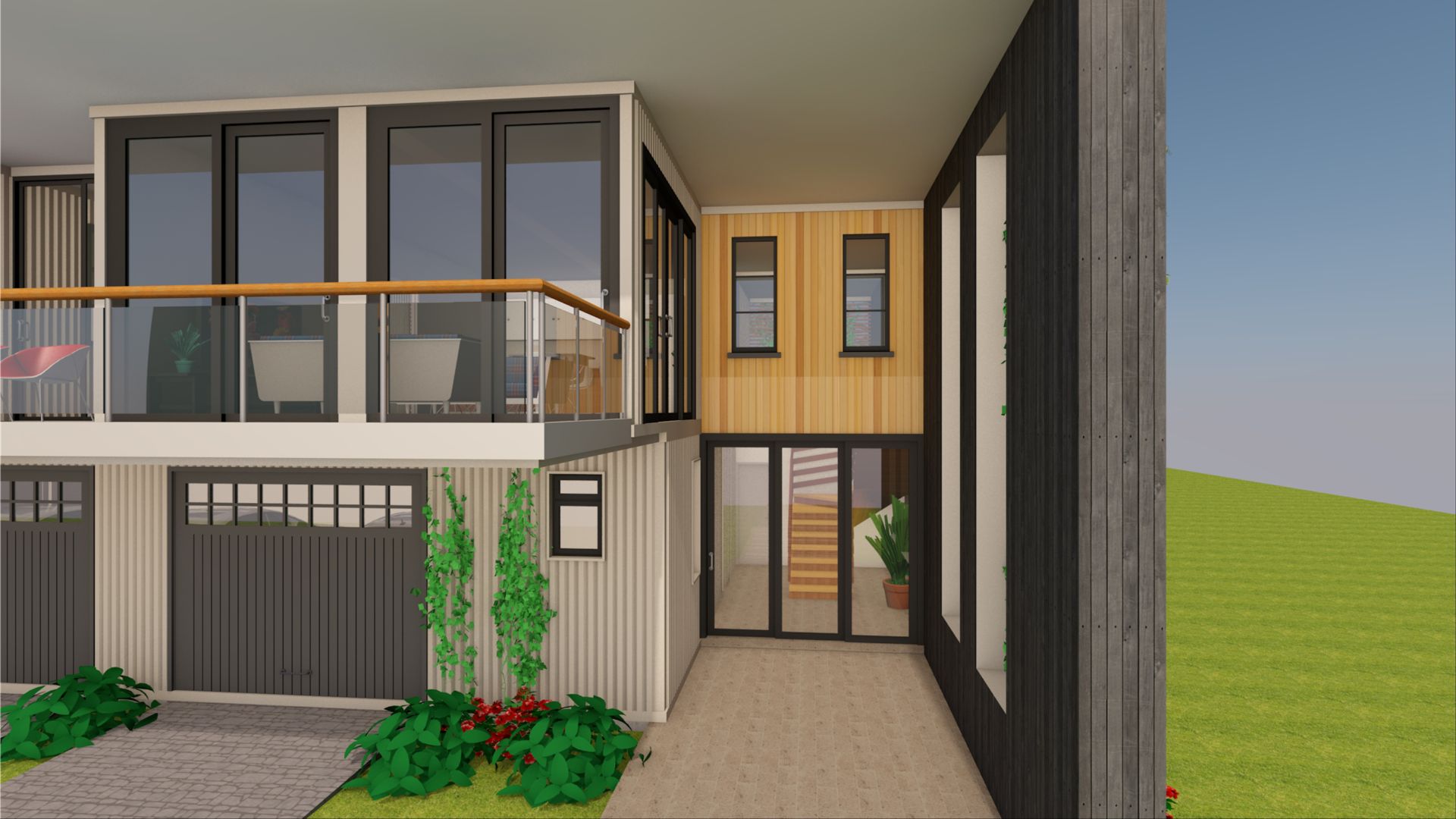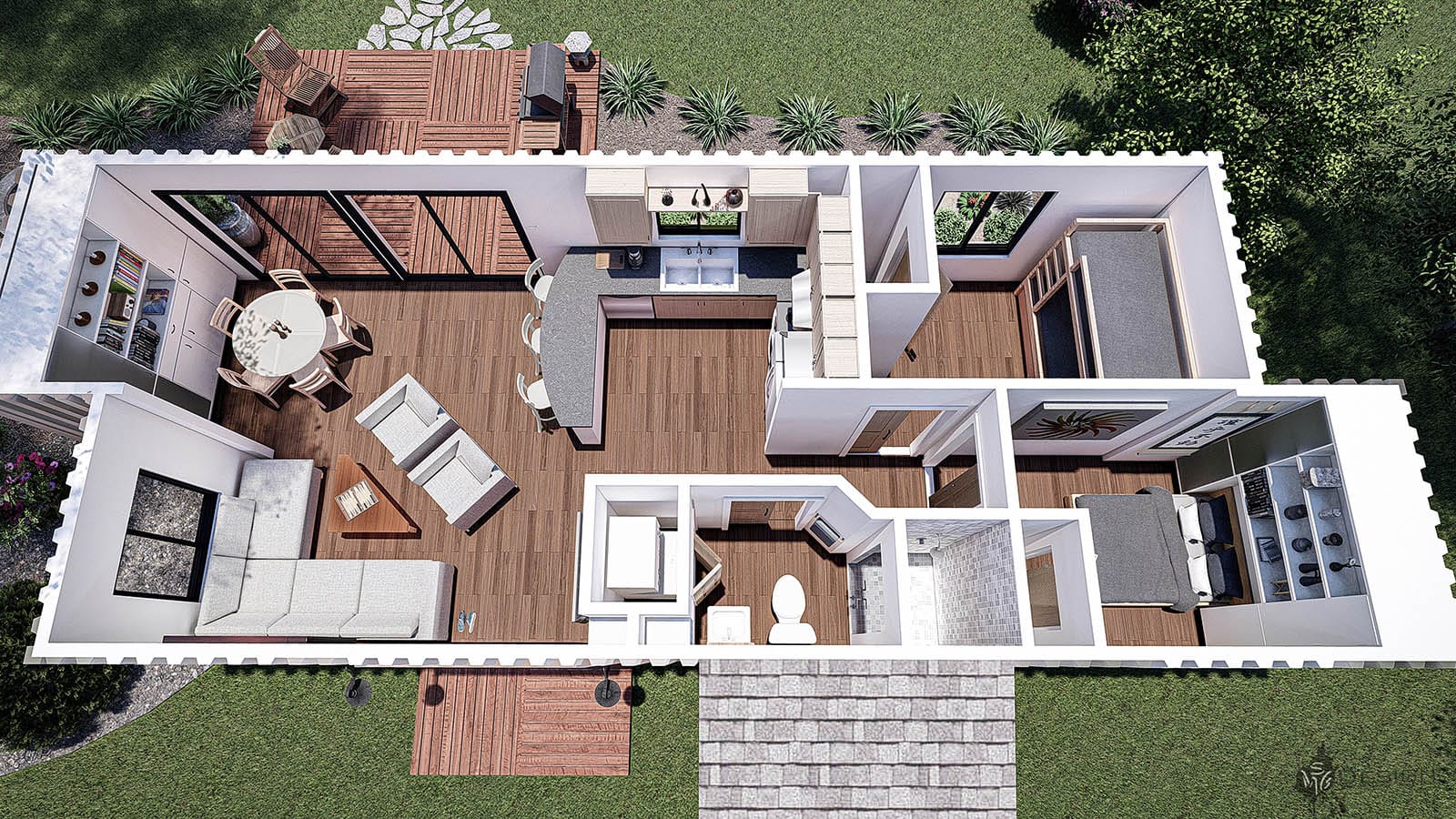The Appeal of Shipping Container Homes

The popularity of shipping container homes has surged in recent years, driven by a growing awareness of their numerous advantages. These homes offer a unique blend of sustainability, affordability, and design flexibility, making them an attractive option for environmentally conscious and budget-minded individuals.
Advantages of Shipping Container Homes, Shipping container homes plans 4 bedroom
The use of shipping containers for home construction presents a compelling alternative to traditional building methods.
- Durability and Strength: Shipping containers are designed to withstand extreme conditions during transportation, making them remarkably durable and robust. Their steel construction provides inherent resistance to fire, pests, and harsh weather elements, ensuring a long-lasting and secure dwelling.
- Cost-Effectiveness: Compared to traditional construction, container homes offer significant cost savings. Shipping containers are readily available at relatively low prices, especially when purchased second-hand. The prefabricated nature of containers reduces labor costs associated with framing and foundation construction.
- Speed of Construction: The modular design of container homes allows for faster construction timelines. Once the containers are delivered to the site, they can be quickly assembled and connected, reducing the overall project duration.
- Flexibility and Customization: Container homes offer a high degree of design flexibility. The containers can be stacked, modified, and combined in various configurations to create unique and personalized living spaces. Interior walls can be easily moved or removed to accommodate changing needs.
Environmental Benefits of Repurposing Shipping Containers
The use of shipping containers for home construction promotes sustainable practices by reducing waste and conserving resources.
- Waste Reduction: Repurposing shipping containers diverts them from landfills, where they would otherwise occupy valuable space and contribute to environmental pollution.
- Resource Conservation: By using pre-existing materials, container homes reduce the need for new raw materials, minimizing the environmental impact associated with extraction and processing.
- Energy Efficiency: The steel construction of shipping containers provides excellent insulation, reducing the need for extensive heating and cooling systems. This contributes to lower energy consumption and reduced carbon emissions.
Cost-Effectiveness of Container Homes
The cost-effectiveness of container homes is a significant factor driving their popularity.
- Lower Material Costs: Shipping containers are readily available at relatively low prices, especially when purchased second-hand. This significantly reduces the material costs associated with home construction.
- Reduced Labor Costs: The prefabricated nature of containers reduces the need for extensive labor involved in framing and foundation construction. This translates into lower labor costs compared to traditional construction.
- Faster Construction Timelines: The modular design of container homes allows for quicker assembly, reducing the overall project duration. This results in lower labor costs and interest expenses associated with financing.
Innovative and Stylish Container Home Designs
Container homes are not limited to basic and utilitarian designs. Architects and designers are pushing the boundaries of creativity, showcasing innovative and stylish container home concepts.
- Multi-Level Designs: Stacking containers vertically allows for the creation of multi-level homes with spacious living areas and unique architectural features.
- Curved and Organic Shapes: Some container homes incorporate curved and organic shapes, blending seamlessly with their surroundings. These designs often feature large windows and open-plan layouts, maximizing natural light and creating a sense of spaciousness.
- Sustainable Features: Many container home designs incorporate sustainable features such as solar panels, rainwater harvesting systems, and green roofs, promoting energy efficiency and environmental responsibility.
Designing a 4-Bedroom Container Home Plan: Shipping Container Homes Plans 4 Bedroom

Designing a 4-bedroom container home requires careful consideration of space utilization, functionality, and aesthetic appeal. The challenge lies in maximizing the limited space within shipping containers while creating a comfortable and practical living environment.
Container Arrangement and Layout Options
The arrangement of containers significantly influences the overall layout and functionality of a 4-bedroom home. Here are some common configurations:
- Linear Arrangement: Containers are placed in a straight line, offering a simple and efficient design. This configuration is suitable for smaller lots and provides a straightforward flow.
- L-Shaped Arrangement: Containers are arranged in an L-shape, creating a more spacious and open feel. This configuration allows for the creation of a central courtyard or outdoor living space.
- U-Shaped Arrangement: Containers are arranged in a U-shape, creating a more enclosed and private living space. This configuration is ideal for larger families or those seeking greater privacy.
Floor Plans and Room Configurations
Once the container arrangement is determined, it’s crucial to plan the layout of rooms. Here are some examples of floor plans and room configurations for a 4-bedroom container home:
- Open-Concept Layout: This layout combines the living, dining, and kitchen areas into one large space, maximizing openness and creating a sense of spaciousness. Bedrooms are typically located on either side of the open-concept area. This configuration is popular for its flexibility and social appeal.
- Split-Level Layout: This layout uses a combination of single-story and two-story container arrangements to create a more dynamic and functional space. The living area can be located on the ground floor, with bedrooms on a raised platform. This configuration offers greater privacy and allows for the incorporation of a balcony or outdoor deck.
- Modular Layout: This layout utilizes individual containers as separate modules for each room, offering flexibility and the ability to customize the design. Bedrooms, bathrooms, and kitchens can be arranged in various configurations to suit specific needs. This configuration is ideal for those seeking greater personalization and flexibility.
Incorporating Bathrooms and Kitchens
Integrating bathrooms and kitchens into a container home requires careful planning and consideration of space constraints.
- Bathroom Design: Compact and efficient bathroom designs are essential. Utilizing space-saving fixtures, such as corner showers and wall-mounted toilets, can maximize functionality. Ventilation is crucial to prevent moisture buildup and ensure a comfortable environment.
- Kitchen Design: A well-designed kitchen in a container home can be achieved by incorporating compact appliances, maximizing vertical space, and utilizing movable islands for additional work surfaces. Strategic placement of cabinets and appliances can create a functional and visually appealing space.
Building and Finishing a 4-Bedroom Container Home

Building a shipping container home requires a methodical approach, encompassing container preparation, structural assembly, and finishing touches. This process ensures a durable and aesthetically pleasing dwelling.
Preparing Shipping Containers for Home Construction
Preparing shipping containers for home construction involves a series of steps to transform them into habitable spaces.
- Cleaning and De-Rusting: Containers are typically used for transporting goods and can accumulate dirt, debris, and rust. Thorough cleaning and de-rusting are essential to create a clean and healthy living environment. This process involves removing loose rust, applying a rust converter, and painting the containers with a rust-resistant primer.
- Cutting and Modifying: Containers are often modified to suit the design of the home. This may involve cutting openings for windows and doors, creating interior partitions, and adding structural supports. Specialized cutting equipment and welding techniques are used to ensure precise and durable modifications.
- Adding Utilities: Essential utilities like electricity, plumbing, and ventilation are integrated into the container structure. Electrical wiring, plumbing pipes, and ventilation ducts are installed to provide basic functionality and comfort.
Connecting and Stacking Containers for a 4-Bedroom Structure
Connecting and stacking shipping containers is a crucial step in creating a multi-bedroom home.
- Structural Support: Containers are typically stacked on a reinforced concrete foundation to ensure stability and longevity. A strong foundation is essential to support the weight of the stacked containers and withstand seismic activity.
- Connecting Containers: Containers are connected using structural steel beams and high-strength bolts. This ensures a secure and rigid connection, preventing movement and maintaining structural integrity.
- Stairwells and Access: Stairwells and access points are incorporated into the design to connect different levels of the structure. This allows for easy movement between floors and provides access to all areas of the home.
Insulation, Roofing, and Siding Options
Insulation, roofing, and siding play a crucial role in creating a comfortable and energy-efficient home.
- Insulation: Shipping containers are often insulated to regulate temperature and prevent heat loss or gain. Common insulation materials include spray foam, fiberglass batts, and rigid foam boards.
- Roofing: Roofing options for container homes vary depending on the climate and design. Popular choices include metal roofing, asphalt shingles, and green roofs.
- Siding: Siding provides a protective layer and enhances the aesthetics of the home. Common siding materials include wood, vinyl, metal, and fiber cement.
Interior Design and Finishing Touches
Interior design and finishing touches personalize the container home and create a welcoming living space.
- Floor Finishes: Flooring options for container homes include hardwood, tile, laminate, and carpet. The choice depends on personal preference and the desired aesthetic.
- Wall Finishes: Walls can be finished with paint, wallpaper, or paneling. These options offer a variety of textures and colors to create the desired ambiance.
- Lighting and Fixtures: Strategic lighting and fixtures can enhance the functionality and aesthetics of the home. Consider using a combination of natural and artificial lighting to create a warm and inviting atmosphere.
- Furniture and Decor: Furniture and decor choices reflect personal style and create a unique living space. Consider using a combination of modern and vintage pieces to add character and personality.
Shipping container homes plans 4 bedroom – Planning a 4-bedroom shipping container home? Imagine the possibilities! You can create a stylish and sustainable space for your family, just like designing a dream bedroom for your little one. Check out these amazing barbie bedroom sets in India for inspiration! Back to your container home, you can incorporate similar design elements to create a fun and functional space for everyone.
Dreaming of a spacious and stylish 4-bedroom shipping container home? Don’t forget to consider the finishing touches, like cozy and inviting bedrooms. For inspiration on creating a luxurious and cohesive look, explore our guide on bedroom bedding sets with curtains , which can help you choose the perfect bedding and window treatments to complete your shipping container home’s design.
